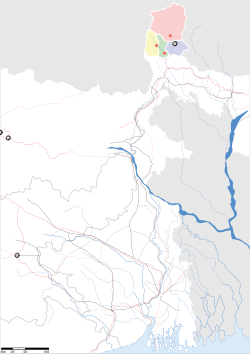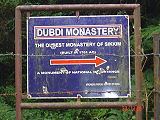- Dubdi Monastery
-
Dubdi Monastery 
Dubdi MonasteryCoordinates: 27°04′N 88°28′E / 27.067°N 88.467°E Monastery information Location Yuksom, Sikkim, India Founded by Lhatsun Namkha Jigme Founded 1701 Type Tibetan Buddhist Sect Nyingma Architecture Tibetan Yuksom, Norbugang Chorten, Norbugang Coronation Throne and the Kathok Lake are within its precincts Dubdi Monastery, occasionally called Yuksom Monastery is a Buddhist monastery of the Nyingma sect of Tibetan Buddhism near Yuksom, in the Geyzing subdivision of West Sikkim district, in northeastern India.[1][2]
The Chogyar Namgyal established the first monastery known as the Dubdi Monastery in 1701, at Yuksom in Sikkim, which is part of Buddhist religious pilgrimage circuit involving the Norbugang Chorten, Pemayangtse Monastery, the Rabdentse ruins, the Sanga Choeling Monastery, the Khecheopalri Lake, and the Tashiding Monastery.[3][4][5]
Established in 1701, it is professed to be the oldest monastery in Sikkim and is located on the top of a hill which is about an hour's walk (3 kilometres (1.9 mi)) from Yuksom. It was also known as the Hermit's Cell after its ascetic founder Lhatsun Namkha Jigme, who along with two other lamas from Tibet met at Norbugang near Yuksom and crowned Phuntsog Namgyal as the first King or Chogyal of Sikkim at Norbugang Yuksom in 1642. The literal meaning of 'Dubdi' in local language is "the retreat".[1][6][7]
Contents
History
Dubdi monastery is central to the history of Sikkkim as it is closely linked to the founding of the State of Sikkim at Yuksom in the middle of the 17th century by Lhetsum Chenpo and his two associate lamas. Chenpo’s green image is enshrined in the Dhubdi monastery as it was established by him to commemorate the founding of the Kingdom of Sikkim. It is the only monastery (purported now as the first monastery built in Sikkim) surviving out of the four built at that time, the other three locations are now identified by: a cluster of four juniper trees was the location where a monastery of Khardokpa sect existed; another location of a monastery established by Lama of Nadakpa sect now seen in the form of a rocky mound and two juniper trees, and the third site has now a chorten, which was originally the location of the residence of the King of Sikkim who was crowned at Yuksom by the three lamas.[8] Monastery had thirty monks some time back. Now to gain access to the monastery, the only monk who stays in the monastery has to be informed in advance.[4]
Architecture
Dubdi stands at a height of 7000 ft on a spur.[9] Established during the reign of Chogyar Namgyal, the Monastery has an elaborately painted interior area. Images of divinities, saints, other symbols and collection of manuscripts and texts are housed in the monastery. The statues of three lamas who were responsible for establishing Yuksom are also installed in the monastery. It is a two storied structure built in stone. It is square in plan and faces south. It has a tapering tower with a flat roof made of iron sheets with projecting eaves. The top of the roof has a bell shaped gilded dome known as “Gyaltshen”. The monastery has two side aisles where a rare collection of manuscripts and other ritual texts are preserved.> [5][6][10]
Gallery
References
- ^ a b "Monasteries". sikkiminfo.in. http://sikkiminfo.in/monasteries.htm. Retrieved November 21, 2009.
- ^ "Monasteries in Sikkim are of three types". Dubdi Monastery. Sikkim Info. http://www.sikkiminfo.net/monasteries.htm. Retrieved 2010-05-05.
- ^ Choudhury, Maitreyee (2006). Sikkim: Geographical Perspects. Mittal Publications. pp. 80–81. ISBN 8183241581. http://books.google.co.in/books?id=W9EwNfXkxZwC&pg=PA81&dq=Dubdi+Monastery,+Sikkim&hl=en&ei=e73gS7GQD8exrAeA3OziBg&sa=X&oi=book_result&ct=result&resnum=2&ved=0CEYQ6AEwAQ#v=onepage&q=Dubdi%20Monastery%2C%20Sikkim&f=false. Retrieved 2010-05-05.
- ^ a b Singh, Sarina (2005). India. Lonely Planet. p. 529. ISBN 1740596943. http://books.google.co.in/books?id=Fk8FQa2ZSFQC&pg=PA529&dq=Dubdi+Monastery+1701&hl=en&ei=n97zS-ThL4-4rAeK0s2gDQ&sa=X&oi=book_result&ct=result&resnum=3&ved=0CDYQ6AEwAg#v=onepage&q=Dubdi%20Monastery%201701&f=false. "... trail leads to Sikkim’s oldest gompa, Dhubdi Monastery. The monastery was established in 1701 and enshrined within it are the statues of the three famous lamas"
- ^ a b Gulia, K.S. (2007). Mountains of the God. Gyan Publishing House. p. 129. ISBN 8182054206. http://books.google.co.in/books?id=K5AaI2PhiV8C&pg=PA129&dq=Dubdi+Monastery+1701&hl=en&ei=n97zS-ThL4-4rAeK0s2gDQ&sa=X&oi=book_result&ct=result&resnum=7&ved=0CEgQ6AEwBg#v=onepage&q=Dubdi%20Monastery%201701&f=false. "Table of Monasteries in Sikkim :Dubdi Monastery, date of building-1701"
- ^ a b "Yuksom in Sikkim". India Study Channel. http://webcache.googleusercontent.com/search?q=cache:IbR1SJ_gcysJ:www.indiastudychannel.com/resources/46936-Yuksom-Sikkim.aspx+Climate+in+Yuksam&cd=1&hl=en&ct=clnk&gl=in. Retrieved 2010-05-07.
- ^ "Monasteries". Dubdi Monastery. National Informatics Centre. http://sikkim.nic.in/sws/glim_mon.htm. Retrieved 2010-05-05.
- ^ Ronaldsha, E (2000). Lands of the thunderbolt: Sikhim, Chumbi & Bhutan. Asian Educational Services. pp. 164–165. ISBN 8120615042. http://books.google.co.in/books?id=CgoHInuX6lMC&pg=PA164&dq=story+of+Dubdi&hl=en&ei=3wnyS4fZBoTHrAenzMTKDQ&sa=X&oi=book_result&ct=result&resnum=4&ved=0CEMQ6AEwAw#v=onepage&q=story%20of%20Dubdi&f=false. Retrieved 200-05-18.
- ^ Freshfield (1903). Round Kangchenjunga: a narrative of mountain travel and exploration. E. Arnold. p. 251. http://books.google.co.in/books?id=RZx-AAAAIAAJ&q=story+of+Dubdi&dq=story+of+Dubdi&hl=en&ei=3wnyS4fZBoTHrAenzMTKDQ&sa=X&oi=book_result&ct=result&resnum=6&ved=0CEwQ6AEwBQ. Retrieved 2010-05-18.
- ^ File:Plaque at Dubdi Monastery.jpg: Official plaque at Dubdi Monastery erected by the Archaeological Survey of India
External links
Categories:- Buddhist monasteries in Sikkim
- Tibetan Buddhist monasteries
- Religious buildings completed in 1701
Wikimedia Foundation. 2010.







